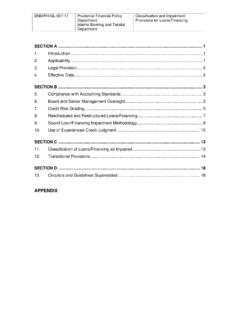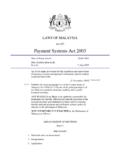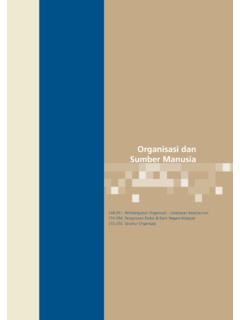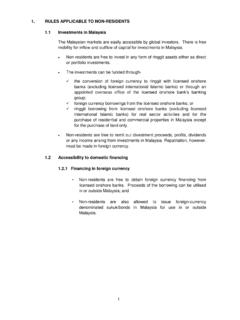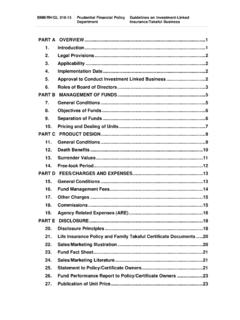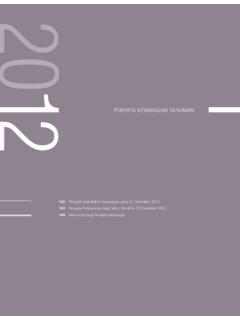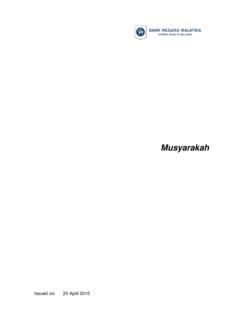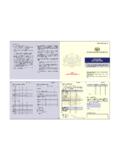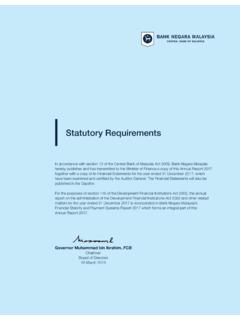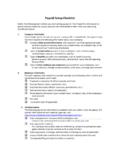Transcription of Anti-Money Laundering and Counter Financing of …
1 Anti-Money Laundering and Counter Financing of Terrorism (AML/CFT) Banking and Deposit-Taking Institutions (Sector 1). Table of Contents PART A OVERVIEW .. 1. 1. Introduction .. 1. 2. 2. 3. Scope .. 2. 4. Legal Provisions .. 3. 5. 3. 6. Effective Date .. 4. 7. Compliance Date .. 4. 8. Policies Superseded .. 4. 9. Relationship with Existing Policies .. 4. 10. Definition and Interpretation .. 5. PART B AML/CFT REQUIREMENTS .. 17. 11. Applicability to Foreign Branches and Subsidiaries .. 17. 12. Risk-Based Approach Application .. 18. 13. Customer Due Diligence (CDD) .. 21. 14. Politically Exposed Persons (PEPs).
2 34. 15. New Products and Business 35. 16. Other Products .. 35. 17. Shell 36. 18. Wire transfer .. 36. 19. money or Value Transfer Services (MVTS) .. 41. 20. Correspondent Banking .. 41. 21. Reliance on Third Parties .. 42. 22. Non Face-to-Face Business Relationship .. 44. 23. Higher Risk Countries .. 45. 24. Failure to Satisfactorily Complete CDD .. 46. 25. Management Information System .. 46. 26. Financial Group .. 47. 27. Record Keeping .. 48. 28. AML/CFT Compliance Programme .. 49. 29. Suspicious Transaction Report .. 59. 30. Cash Threshold Report .. 64. 31. Combating the Financing of Terrorism.
3 66. 32. Non-Compliance .. 68. BNM/RH/STD 028-1 Financial Intelligence Anti-Money Laundering and Counter Page and Enforcement Financing of Terrorism (AML/CFT) 1 of 75. Department Banking and Deposit-Taking Institutions (Sector 1). PART A OVERVIEW. 1. Introduction money Laundering and terrorism Financing (ML/TF) continues to be an on-going threat which has the potential to adversely affect the country s reputation and investment climate, which may lead to economic and social consequences. The globalisation of the financial services industry and advancement in technology has posed challenges to regulators and law enforcement agencies as criminals have become more sophisticated in utilising reporting institutions to launder illicit funds and use them as conduits for ML/TF activities.
4 Since the formation of the National Coordination Committee to Counter money Laundering (NCC), efforts have been undertaken to effectively enhance the AML/CFT compliance framework of reporting institutions resulting in the introduction of the Standard Guidelines on Anti-Money Laundering and Counter Financing of Terrorism (UPW/GP1) and the relevant Sectoral Guidelines. While these efforts have addressed the ML/TF risks and vulnerabilities, there is a need to continuously assess the effectiveness of our AML/CFT framework to ensure that it continues to evolve in line with developments in international standards and the global environment.
5 Prior to 2012, the Financial Action Task Force (FATF) undertook a comprehensive review of the 40+9 Recommendations, which aimed at bringing the Recommendations more up-to-date with the evolving financial, law enforcement and regulatory environment besides addressing new and emerging threats. The 2012 revision, the International Standards on Combating money Laundering and the Financing of Terrorism & Proliferation (FATF 40 Recommendations), sought to clarify and strengthen many of its existing obligations as well BNM/RH/STD 028-1 Financial Intelligence Anti-Money Laundering and Counter Page and Enforcement Financing of Terrorism (AML/CFT) 2 of 75.
6 Department Banking and Deposit-Taking Institutions (Sector 1). as to reduce duplication in the Recommendations. One of the new Recommendations introduced is on the obligation of countries to adopt a risk-based approach in identifying, assessing and understanding the countries ML/TF risks, which places further expectation on reporting institutions to assess and mitigate ML/TF risks. Premised on the foregoing paragraphs, reporting institutions must conduct their business in conformity with high ethical standards and be on guard against undertaking any business transaction that is or may be connected with or may facilitate ML/TF.
7 These underlying principles become the basis upon which the integrity and soundness of the Malaysian financial system must be safeguarded. 2. Objective This document is formulated in accordance with the provisions of the Anti-Money Laundering and Anti-Terrorism Financing Act 2001. (AMLATFA) and the FATF 40 Recommendations and is intended to ensure that reporting institutions understand and comply with the requirements and obligations imposed on them. 3. Scope This document sets out the: (a) obligations of reporting institutions with respect to the requirements imposed under the AMLATFA;. (b) requirements imposed on reporting institutions in implementing a comprehensive risk-based approach in managing ML/TF risks.
8 And (c) roles of the reporting institutions Board of Directors and Senior Management in putting in place the relevant AML/CFT measures. BNM/RH/STD 028-1 Financial Intelligence Anti-Money Laundering and Counter Page and Enforcement Financing of Terrorism (AML/CFT) 3 of 75. Department Banking and Deposit-Taking Institutions (Sector 1). 4. Legal Provisions This document is issued pursuant to: (a) Sections 13, 14, 15, 16, 17, 18, 19, 20, 66E and 83 of the AMLATFA;. (b) Section 47(1) and in particular, Paragraph 47(2)(h) of the Financial Services Act 2013 (FSA);. (c) Section 57(1) and in particular, Paragraph 57(2)(h) of the Islamic Financial Services Act 2013 (IFSA); and (d) Section 126 of the Development Financial Services Act 2002.
9 (DFIA). 5. Applicability This document is applicable to: (a) reporting institutions carrying on the following activities listed in the First Schedule to the AMLATFA: (i) banking business and investment banking business as defined in the FSA;. (ii) Islamic banking business as defined in the IFSA;. (iii) business activities carried out by the prescribed institutions as defined in the DFIA;. (iv) activities carried out by Lembaga Tabung Haji established under the Tabung Haji Act 1995; and (v) any other persons as specified by Bank Negara Malaysia;. (b) branches and subsidiaries of reporting institutions referred to in Paragraph (a) which carries on any activity listed in the First Schedule of the AMLATFA; and (c) all products and services offered by reporting institutions referred to in Paragraph (a).
10 BNM/RH/STD 028-1 Financial Intelligence Anti-Money Laundering and Counter Page and Enforcement Financing of Terrorism (AML/CFT) 4 of 75. Department Banking and Deposit-Taking Institutions (Sector 1). Where reporting institutions are subject to more than one document relating to AML/CFT matters issued pursuant to section 83 of the AMLATFA, the more stringent requirement shall apply. 6. Effective Date This document comes into effect on 15 September 2013. 7. Compliance Date Compliance to the requirements outlined in this document shall take effect immediately, unless otherwise specified by Bank Negara Malaysia.
